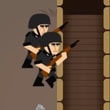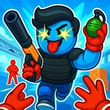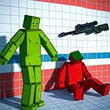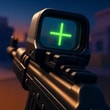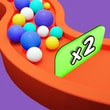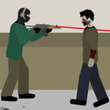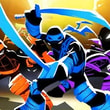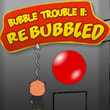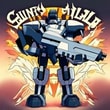The bell doesn’t ring; the air cracks. Two shadows flicker across a painted sky, a scarf snaps like a flag, and the ground remembers every battle it’s ever held. Bleach Vs Naruto 2.0 is a crossover fever dream that plays like a love letter to arcade fighting—fast footsies, rude mix-ups, and supers that turn the screen into a poster. You tag in a partner, call an assist that hits like a whispered secret, and ride a combo into an ultimate that silences the crowd in your head. It’s precise without being precious, stylish without wasting time, and somehow feels both Saturday-night-versus and after-school button mashing in the same heartbeat.
⚡ Momentum, Meter, Mayhem
Every match is a story told in meters. You watch the super bar swell, feel the rhythm of dash cancels, and decide whether to cash out damage or keep pressure and taste the panic on the other side. Light chains sketch the outline, mediums add shading, heavies ink the page. When the confirm lands—one clean jab, a dash, a launcher—you’re suddenly writing in capital letters. Spend half a bar to extend, burn it all on a cinematic finisher, or save for the hard knockdown that sets up the nastiest left-right you’ve found this week. The game gives you tools; the greed is all yours.
🌀 Tag Team That Actually Feels Like Team
You don’t pick one hero; you pick a duo and a philosophy. Frontliner bullies with frame advantage, partner covers your sins and sharpens your win condition. Swap mid-string to steal corner advantage, call a fast poke assist to steal a turn you didn’t earn, or choose a big-body summon that forces respect before your next approach. Good teams sound like music: touch, call, dash, set, strike. Bad teams sound like a dropped drum kit, still loud, occasionally effective, never boring. Either way, momentum keeps moving and you learn to surf.
🗡️ Swords, Seals, and Screenshake
Styles clash in the most satisfying ways. Sword users paint long diagonals that slice space and force careful jumps. Chakra slingers own the midrange with rude projectiles and teleport feints that make the ground feel optional. Grapplers, yes, they exist, and yes, they are problems up close, turning timid blocks into regret. The magic is in the interplay: anti-airs that spike daydreaming dashers, counters that sip up overextensions, guard breaks that punish bunker play. Every matchup becomes a conversation—sometimes polite, usually not—about who gets to tell the story of this round.
🌪️ Neutral Game, Not Neutral Feelings
Footsies matter. You inch into poke range, test with a safe light, and get checked by a low you swear you blocked. Next time you preempt with a dash block, watch a fireball sail by, and punish with something theatrical because theatrics are good for morale. Short hops bait anti-airs, empty jumps bait throws, and walk-back whiff-punish is the kind of quiet violence that makes you grin. The stage is wide, the corners are loud, and the sweet spot between them is where players become problems.
🔥 Supers That Earn The Spotlight
Ultimates are seasoning, not sauce, and landing one feels like breaking the seal on an action movie. Screen dims, voice lines slice the mix, and the background explodes in ink and speed lines while damage math does push-ups behind the curtain. The best part is the route that got you there: assist into juggle, micro-dash, late cancel, confirm. You planned it in the training room. You landed it live. Your thumbs demand a trophy no one will mail. That’s fine. You’ll take the round instead.
🎯 Defense With Dignity
Blocking is not a timeout; it’s a test. High-low strings demand posture changes that feel like dance steps, and throws crack turtles just enough to keep things honest. Delayed wakeups ruin meaty autopilots, push-blocks buy air when your lungs need it, and parries—oh, parries—turn panic into poetry when you nail one on a multi-hit special that looked like a mistake to challenge. The win state isn’t always damage; sometimes it’s patience that turns an opponent’s bar into your opportunity.
🧠 Lab Monsters Welcome
The training mode is a science classroom with cool posters. Record reversals to practice safe meaties. Set guard settings to cycle random and force your mix-ups to be real. Learn character-specific routes that trade raw damage for corner carry or vice versa. Tighten links from “probably” into “of course.” Discover that your day-one favorite combo scales poorly after two assists and build a new one that ends in a dirty reset instead. You will mutter frame numbers. You will grin anyway.
🎮 Controls That Disappear
Inputs are friendly, execution is honest. Quarter-circles, charge specials for the stubborn, a universal launcher that keeps new players from feeling lost, and just enough leniency to reward intention without turning everything into soup. Air dashes exist but don’t break the ground game. Short hops have purpose beyond style. Macro buttons for assist and tag mean you’re thinking about strategy, not finger gymnastics. After ten matches, your hands stop voting and start governing.
👥 Roster Vibes You Can Feel
The cast wears its heart on its sleeves. Speedsters move like bad ideas that worked. Zoners plant runic landmines and smile with their eyes. Bruisers stomp, then invite you to discuss consequences at close range. Support picks cloak matches in utility: a heal tick that flips end-game calculus, a clone feint that buys entry, a wall that turns corner scrambles into corner sermons. You’ll main who you love and side-eye who you fear. That’s the healthy cycle.
🏟️ Stages With Energy
Each arena frames the action with personality—night markets buzzing under neon, wind-torn plateaus, courtyard tiles scuffed by a hundred duels. Nothing interferes with clarity. Everything feeds the pulse. Corner spacing feels consistent, wall splats behave, and the subtle parallax earns its keep by making supers pop without stealing the fight’s legibility. You’ll pick favorites and swear they make you play better. They might.
🔊 Audio That Coaches And Celebrates
Hit sparks snap with different timbres so you can confirm without looking. Heavy normals thud like drum fills; specials crackle and leave a sizzle that tells you whether you’re plus or about to be very minus. Voice lines taunt but also signal states—charge gained, mode activated, assist on cooldown. The soundtrack shifts gears when the last pixel standoff begins, and that tiny tempo bump is sometimes enough to make your fingers brave.
🧭 Modes For Any Mood
Arcade strings rivals into a brisk tour of the roster with goofy rival intros and mid-boss swagger. Versus is the living room truth serum: best-of-fives that become best-of-forevers because someone lost by a pixel and refuses to sleep like that. Survival turns the game into resource math—meter carry, damage minimization, risk budgets. Time Attack dares you to end rounds efficiently instead of extravagantly, which is rude and good for you. Training, as mentioned, will steal hours and give skill back with interest.
📈 Improvement You Can Feel
Day one, you mash and sparkle. Day three, you anti-air on purpose. Day seven, you bait a burst, punish clean, route into corner, and cash out only after you steal their last option with a meaty assist that looked accidental and absolutely wasn’t. The curve is friendly at the start and steep where you want it: on mastery, not menu reading.
💡 Match Tips You’ll Pretend You Discovered
Don’t jump at round start; watch. Dash block to steal space without donating counter-hits. Use assists as insurance when your string gap might be exposed. End combos in oki, not vanity—advantage wins more sets than highlight reels ever will. Against zoners, spend meter to skip a phase; against rushdown, challenge the minus-two habit you’ve scouted. If you’re cornered, tech roll late once per set just to make a note in their brain. Then cash in later.
🌟 Why It Belongs In Your Kiz10 Rotation
Because it’s fast without being frantic, deep without gatekeeping, and shamelessly cool. Because tag mechanics turn every round into a two-brain puzzle even when you’re playing solo. Because the supers make you gasp, the scrambles make you laugh, and the small improvements stack into something you can feel in your hands. Bleach Vs Naruto 2.0 on Kiz10 is old-school heart with new-school swagger—the kind of fighter you boot for “one set” and realize, three hours later, that you’re still chasing that perfect confirm into the perfect finish.
 Bleach Vs Narut
Bleach Vs Narut
